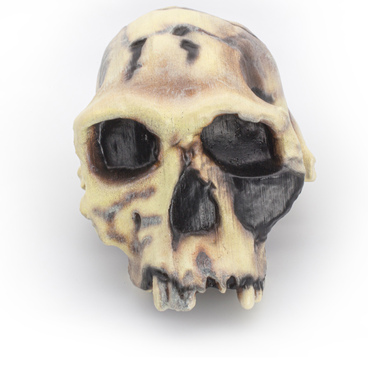People have been catching fish since ancient times, as evidenced by archaeological findings. The earliest evidence is found at the Late Paleolithic site of Malta, which is 24-26 millennia old. There, scientists found large fish bones and beads made from taimen vertebrae. However, it is impossible to establish exactly when fishing appeared in Siberia.
Most likely, the ancient inhabitants of Siberia originally caught fish with their hands, and later learned to create gear and devices for fishing. Archaeologists found all sorts of equipment: harpoons, baits, hooks and nets.
The rod in the collection of the Museum of Regional Studies is part of an ancient composite fishhook. Similar products were used in Eastern Siberia in the Neolithic period (4-7 thousand years ago), especially in the period of the Kitoi culture (about 5.8-7 thousand years ago). The rods were made of stone. Sharp bone stingers were attached to them on one side, and a cord was tied to them on the other.
Archaeologists did not immediately understand how the object was used: the first finds, made in the 19th century, were mistaken by scientists for fish sculptures and symbolic signs. Later it became clear that these products were used to catch fish, but it was not known exactly how the tackle was constructed. It was not until 1928 that researcher Mikhail Gerasimov discovered the assembled hook, which lay in the burial ground in the form in which it had been used. Thanks to this find, scientists have established exactly how the bone pincer was attached and thus what the early fishing gear looked like in Siberia.
Such fishing hook rods are the item most commonly found in the burials of the Kitoi culture. For example, more than 150 similar rods of different sizes, from 0.9 to 15 centimeters, were found at the excavation of the Lokomotiv archaeological site. Among the finds was an object that is now stored in the Regional Museum of Local History — it was donated to the museum by archaeologist Pavel Khoroshikh. In addition to rods, bait fish, an ancient version of the modern spinner, were often found at the excavations of the Lokomotiv burial ground.
Most likely, the ancient inhabitants of Siberia originally caught fish with their hands, and later learned to create gear and devices for fishing. Archaeologists found all sorts of equipment: harpoons, baits, hooks and nets.
The rod in the collection of the Museum of Regional Studies is part of an ancient composite fishhook. Similar products were used in Eastern Siberia in the Neolithic period (4-7 thousand years ago), especially in the period of the Kitoi culture (about 5.8-7 thousand years ago). The rods were made of stone. Sharp bone stingers were attached to them on one side, and a cord was tied to them on the other.
Archaeologists did not immediately understand how the object was used: the first finds, made in the 19th century, were mistaken by scientists for fish sculptures and symbolic signs. Later it became clear that these products were used to catch fish, but it was not known exactly how the tackle was constructed. It was not until 1928 that researcher Mikhail Gerasimov discovered the assembled hook, which lay in the burial ground in the form in which it had been used. Thanks to this find, scientists have established exactly how the bone pincer was attached and thus what the early fishing gear looked like in Siberia.
Such fishing hook rods are the item most commonly found in the burials of the Kitoi culture. For example, more than 150 similar rods of different sizes, from 0.9 to 15 centimeters, were found at the excavation of the Lokomotiv archaeological site. Among the finds was an object that is now stored in the Regional Museum of Local History — it was donated to the museum by archaeologist Pavel Khoroshikh. In addition to rods, bait fish, an ancient version of the modern spinner, were often found at the excavations of the Lokomotiv burial ground.



